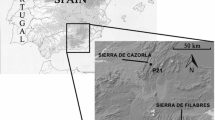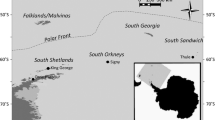Abstract
Since some colonies of Argentine ant Linepithema humile were discovered in Japan in 1993, populations of this invasive alien ant species have been expanding their distribution. To resolve the number of invasions and the genetic structure in the early stages of introduction, we inferred the genetic structure and relationships among colonies from eight localities, from analyses of eight nuclear microsatellite DNA markers. F ST analysis, principal component analysis and assignment test showed that at least three highly genetically differentiated groups of Argentine ants are present in Japan. Populations from Hiroshima Bay were grouped together (Hiroshima, Hatsukaichi, Otake, Iwakuni Central and Iwakuni Kuroiso), while those from Kobe and Yanai were both genetically distant from each other and from the Hiroshima Bay group. Hatsukaichi and Kobe are international seaports, suggesting that the by-ship invasion occurred at least twice. The invasion route of the Yanai population is unknown at this moment. The Aichi population was genetically distant from that of the Hiroshima Bay group by the difference in allele frequencies, and it was plausible that the Aichi population was introduced from the Hiroshima Bay group by human-mediated jump dispersal.




Similar content being viewed by others
References
Barber ER (1916) The Argentine ant: distribution and control in the United States. Bureau Entomol Bull 377:1–23
Buczkowski G, Vargo E, Silverman J (2004) The diminutive supercolony: the Argentine ants of the southeastern United States. Mol Ecol 13:2235–2242
Cole FR, Medeiros AC, Loope LL, Zuehlke WM (1992) Effects of the Argentine ant on arthropod fauna of Hawaiian high-elevation shrubland. Ecology 73:1313–1322
De Kock AE, Giliomee JH (1989) A survey of the Argentine ant, Iridomyrmex humilis (Mayr), (Hymenoptera, Formicidae) in South African fynbos. J Entomol Soc S Afr 52:157–164
Giraud T, Pedersen JS, Keller L (2002) Evolution of supercolonies: the Argentine ants of southern Europe. Proc Natl Acad Sci U S A 99:6075–6079
Gómez C, Pons P, Bas JM (2003) Effects of the Argentine ant Linepithema humile on seed dispersal and seedling emergence of Rhamnus alaternus. Ecography 26:532–538
Guo SW, Thompson EA (1992) Performing the exact test of Hardy–Weinberg proportion for multiple alleles. Biometrics 48:361–72
Holway DA (1995) The distribution of the Argentine ant (Linepithema humile) in central California: a twenty year record of invasion. Conserv Biol 9:1634–1637
Holway DA (1998) Effect of Argentine ant invasions on ground dwelling arthropods in northern California riparian woodlands. Oecologia 116:252–258
Human KG, Gordon DM (1996) Exploitation and interference competition between the invasive Argentine ant, Linepithema humile, and native ant species. Oecologia 105:405–412
Jackson DA (1993) Stopping rules in principal component analysis: a comparison of heuristical and statistical approaches. Ecology 74:2204–2214
Jaquiéry J, Vogel V, Keller L (2005) Multilevel genetic analyses of two European supercolonies of the Argentine ant, Linepithema humile. Mol Ecol 14:589–598
Kameyama T (2001) A distribution record of Linepithema humile in Yanai City, Yamaguchi Prefecture. ARI. J Myrmecol Soc Jpn 25:4–6 (in Japanese with English abstract)
Krieger MJB, Keller L (1999) Low polymorphism at 19 microsatellite loci in a French population of Argentine ants (Linepithema humile). Mol Ecol 8:1078–1080
Markin GP (1970) Seasonal life cycle of Argentine ant, Iridomyrmex humilis (Hymenoptera, Formicidae), in Southern California. Ann Entomol Soc Am 63:1238–1242
Murakami K (2002) Exotic ants in Portisland, Kobe City. ARI. J Myrmecol Soc Jpn 26:45–46 (in Japanese with English abstract)
Passera L, Keller L (1992) The period of sexual-maturation and the age at mating in Iridomyrmex humilis, an ant with intranidal mating. J Zool 228:141–153
Pritchard JK, Stephens M, Donnelly P (2000) Inference of population structure using multilocus genotype data. Genetics 155:945–959
Schneider S, Roessli D, Excoffier L (2000) Arlequin: a software for population genetics data analysis. Version 2.000. Genetics and Biometry Laboratory, Department of Anthropology, University of Geneva
Suarez AV, Bolger DT, Case TJ (1998) Effects of fragmentation and invasion on native ant communities in coastal southern California. Ecology 79:2041–2056
Suarez AV, Holway DA, Case TJ (2001) Patterns of spread in biological invasions dominated by long-distance jump dispersal: insights from Argentine ants. Proc Natl Acad Sci U S A 98:1095–1100
Sugiyama T (2000) Invasion of Argentine ant, Linepithema humile, into Hiroshima Prefecture, Japan. Jpn J Appl Entomol 44:127–129 (in Japanese with English abstract)
Thomas ML, Payne-Makrisâ CM, Suarez AV, Tsutsui ND, Holway DA (2006) When supercolonies collide: territorial aggression in an invasive and unicolonial social insect. Mol Ecol 15:4303–4315
Touyama Y (2001) Report of Argentine ant’s invasion into Iwakuni City, Yamaguchi Prefecture. ARI. J Myrmecol Soc Jpn 25:1–3 (in Japanese with English abstract)
Touyama Y, Ogata K, Sugiyama T (2003) The Argentine ant, Linepithema humile, in Japan: assessment of impact on species diversity of ant communities in urban environments. Entomol Sci 6:57–62
Tschinkel WR (2006) The Fire Ants. Harvard University Press, Cambridge
Tsutsui ND, Case TJ (2001) Population genetics and colony structure of the Argentine ant (Linepithema humile) in its native and introduced ranges. Evolution 55:976–985
Tsutsui ND, Suarez AV, Holway DA, Case TJ (2000) Reduced genetic variation and the success of an invasive species. Proc Natl Acad Sci U S A 97:5948–5953
Van Oosterhout C, Hutchinson WF, Wills DPM, Shipley P (2004) MICRO-CHECKER: software for identifying and correcting genotyping errors in microsatellite data. Mol Ecol Notes 4: 535–538
Vega SY, Rust MK (2001) The Argentine ant: significant invasive species in agricultural, urban and natural environments. Sociobiology 37:3–25
Acknowledgments
We would like to express our sincere thanks to Dr. K. Ogata, Kyusyu University, for identification of materials, Dr. F. Ito, Kagawa University, for providing us with information from the study sites, Dr. J. S. Pedersen, University of Copenhagen, for providing us with the molecular information, and Mr. A. Abe, Meijo University, for sampling. We also thank the Ministry of the Environment for providing some materials. This research was supported by the Ministry of Education, Science, Sports and Culture, Grant-in-Aid for Scientific Research (A), 17207003, 2005.
Author information
Authors and Affiliations
Corresponding author
About this article
Cite this article
Hirata, M., Hasegawa, O., Toita, T. et al. Genetic relationships among populations of the Argentine ant Linepithema humile introduced into Japan. Ecol Res 23, 883–888 (2008). https://doi.org/10.1007/s11284-007-0450-4
Received:
Accepted:
Published:
Issue Date:
DOI: https://doi.org/10.1007/s11284-007-0450-4




